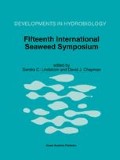Abstract
Tank cultivation of Gracilaria using fish effluents has permitted a production of 48 kg m-2 yr-1 and can reduce the dissolved nitrogen loads in the seawater. We report the yield, gel strength, gelling and melting point of agar from Gracilaria cultivated in tanks with seawater previously utilized in intensive, land-based salmon cultures and compared to a control using directly pumped seawater, over a study period of 22 months. The results show that the highest agar yield (20 to 22%) was obtained when Gracilaria was cultivated with pure seawater as compared to the fish effluents. The gel strength, gelling and melting point were higher in the agar obtained from algae cultured with fish effluents. During the spring, the gel strength, gelling and melting point increased in tanks with fish effluents and decreased in tanks with a supply of pure seawater.
Access this chapter
Tax calculation will be finalised at checkout
Purchases are for personal use only
Preview
Unable to display preview. Download preview PDF.
References
Bird, K. T., M. D. Hanisak & J. Ryther, 1981. Chemical quality and production of agars extracted from Gracilaria tikvahiae grown in different enrichment conditions. Bot. mar. 24: 441–444.
Boeuf, G., H. Kossmann & A. Medina, 1992. Le développment de la salmoniculture au Chili en 1992. Pisciculture Française 109: 5–17.
Buschmann, A. H., D. A. López & A. Medina, 1993. Costos y tecnologías para minimizar el impacto ambiental. Ambiente y Desarrolio 9:71–75.
Buschmann, A. H., O. Mora, P. Gómez, M. Böttger, S. Buitano, C. Retamales, P. Vergara & A. Gutierrez, 1994. Gracilaria outdoor tank cultivation in Chile: use of land-based salmon culture effluents. Aquacult. Engin. 13: 283–300.
Buschmann, A. H., R. Westermeier & C. Retamales, 1995. Gracilaria cultivation on the sea bottom in Chile: a review. J. appl. Phycol. 7:291–301.
Cancino, J. & M. C. Orellana, 1987. Interaction entre Gracilaria verrucosa y su fauna epífita: perspectivas para la utilización de mitílidos como fuente de nutrientes en cultivo de Gracilaria en piscinas. In J. A. Verreth, M. Carrillo, S. Zanuy & E. A. Huisman (eds.), Investigaciones Acuícola en América Latina. Pudoc Press, Wageningen: 380–392.
Chiles, T. C, K. T. Bird & F. E. Koehn, 1989. Influence of nitrogen availability on agar-polysaccarides from Gracilaria verrucosa strain G-16: structural analysis by NMR spectroscopy. J. appl. Phycol. 1:53–58.
Craigie, J. S. & Z. C. Wen, 1984. Effects of temperature and tissue age on gel strength and composition of agar from Gracilaria tikvahiae (Rhodophyceae). Can. J. Bot. 62: 1665–1670.
Craigie, J. S., Z. C. Wen & J. P. van der Meer, 1984. Interspecific, intraspecific and nutritionally-determined variations in the composition of agars from Gracilaria spp. Bot. mar. 27: 55–61.
DeBoer, J. A., 1979. Effects of nitrogen enrichment on growth rate and phycocolloid content in Gracilaria foliifera and Neoagard-hiella baileyi. Proc. int. Seaweed Symp. 9: 263–271.
Kim, D. H., 1970. Economically important seaweeds in Chile — I. Gracilaria. Bot. mar. 13: 140–162.
Lignell, A. & M. Pedersén, 1989. Agar composition as a function of morphology and growth rate. Studies on some morphological strains of Gracilaria secundata and Gracilaria verrucosa (Rhodophyta). Bot. mar. 32: 219–227.
Martinez, L. A., 1994. Uso de efluentes de salmonideos para el cultivo de Gracilaria chilensis en estanques: Rendimiento y calidad de agar. Food Engineering Thesis, Universidad de Los Lagos, Osorno, Chile, 80 pp.
Medina, A., N. Pardo, C. Vargas, J. C. Uribe & A. H. Buschmann, 1993. Un estudio comparativo del cultivo de Oncorhynchus kisutch en estanques costeros y balsas jaula en el sur de Chile. Rev. Biol. Mar. (Valparaíso) 28: 247–259.
Pickering, T. D., V. H. Sladden, R. H. Furneaux, J. A. Hemmingson & P. Redfearn, 1993. Comparison of growth rate in culture, dry matter content, agar content and agar quality of two New Zealand red seaweeds, Gracilaria chilensis Bird, McLachlan et Oliveira and Gracilaria truncata Kraft. J. appl. Phycol. 2: 273–279.
Retamales, C. A., L. A. Martinez & A. H. Buschmann, 1996. Mantención interanual de los niveles productivos y del rendimiento de agar de Gracilaria chilensis cultivada en estanques en el sur de Chile. Rev. Biol. Mar. (Valparaiso) 29: 251–261.
Rotem, A., N. Roth-Bejerano & S. (Mahlis) Arad, 1986. Effect of controlled environmental conditions on starch and agar contents of Gracilaria sp. (Rhodophyceae). J. Phycol. 22: 117–121.
Santelices, B. & M. Doty, 1989. A review of Gracilaria farming. Aquaculture 78: 95–133.
Sokal, R. R. & F. J. Rohlf, 1979. Biometría. Ediciones H. Blume, Barcelona, 832 pp.
Tarn, D. M. & P. Edwards, 1982. Seaweeds of economic importance in Thailand. Part 2. Analysis of agar from Gracilaria. Bot. mar. 25: 459–465.
Yaphe, W. & M. Duckworth, 1972. The relationship between structure and biological properties of agars. Proc. int. Seaweed Symp. 7: 15–22.
Yü, S. & M. Pedersén, 1991. Carbon partitioning in red algae. Influence of NH4+/N03-, salinity and darkness on the carbon flow into cell wall polymers, floridean starch and floridoside. In G. García-Reina & M. Pedersén (eds.), Seaweed Cellular Biotechnology, Physiology and Intensive Cultivation. Universidad de Las Palmas, Las Palmas de Gran Canarias: 167–183.
Author information
Authors and Affiliations
Editor information
Editors and Affiliations
Rights and permissions
Copyright information
© 1996 Kluwer Academic Publishers
About this paper
Cite this paper
Martinez, L.A., Buschmann, A.H. (1996). Agar yield and quality of Gracilaria chilensis (Gigartinales, Rhodophyta) in tank culture using fish effluents. In: Lindstrom, S.C., Chapman, D.J. (eds) Fifteenth International Seaweed Symposium. Developments in Hydrobiology, vol 116. Springer, Dordrecht. https://doi.org/10.1007/978-94-009-1659-3_48
Download citation
DOI: https://doi.org/10.1007/978-94-009-1659-3_48
Publisher Name: Springer, Dordrecht
Print ISBN: 978-94-010-7242-7
Online ISBN: 978-94-009-1659-3
eBook Packages: Springer Book Archive

